Theoretical investigation of electron-impact ionization of W8+ion
Shiping Zhang(张世平), Fangjun Zhang(张芳军), Denghong Zhang(张登红), Xiaobin Ding(丁晓彬),Jun Jiang(蒋军), Luyou Xie(颉录有), Yulong Ma(马玉龙), Maijuan Li(李麦娟),Marek Sikorski, and Chenzhong Dong(董晨钟)
Key Laboratory of Atomic and Molecular Physics&Functional Materials of Gansu Province,College of Physics and Electronic Engineering,Northwest Normal University,Lanzhou 730070,China
Keywords: tungsten ions,electron-impact ionization,cross section
1.Introduction
Tungsten is utilized to coat sections of the inner walls in fusion devices due to its exceptional attributes, including a high melting point, resistance to neutron radiation, low tritium retention, and minimal chemical erosion.[1,2]When energetic particles bombard the inner walls, tungsten atoms are expelled and migrate towards the central regions of the thermonuclear plasma.During their journey from the wall regions to the plasma center, these tungsten atoms undergo multiple ionizations.The presence of tungsten ions in the plasma significantly contributes to radiative losses.Consequently, precise atomic data are indispensable for forecasting the impact of tungsten as a plasma impurity on plasma performance,encompassing atomic processes and the atomic structure of tungsten across all charged states.[3]Among the various ionization processes in fusion plasma, electron-impact single ionization(EISI) stands as the most dominant.[4,5]Therefore, comprehensive knowledge of ionization cross sections for tungsten ions,extending up to the highest charge states,is essential for fusion plasma modeling.
Over the years, investigations related to electron-impact ionization of tungsten have been conducted.Montague and Harrison[6]initially presented experimental cross sections for single ionization of W+.These results were subsequently corroborated by Stenkeet al.,[7]encompassing a range of Wq+(whereq= 1-10).Additional, experimental cross sections were measured for W17+and W19+using an electron-ion crossed-beam setup.[4,8]Most recently,Schuryet al.addressed the remaining gap for low to moderately high charge states with measurements for Wq+(where 11≤q ≤18).[9]
Theoretically, calculating electron-impact ionization(EII)cross sections for tungsten ions presents challenges due to its complex many-electron nature, relativistic effects, and the presence of open d or f shells.Consequently,several theoretical methods have been employed, including the widely used Lotz expression,[10]binary-encounter Bethe (BEB)model,[11,12]plane-wave Born(PWB)approximation,[13,14]Rmatrix method,[15]and configuration-averaged distorted wave(CADW) method.[16]For instance, Kwonet al.calculated cross sections for the electron-impact ionization of neutral W atoms and W+ions using the BEB model and PWB approximation.[17]Balanceet al.employed the distorted wave theory to calculate direct ionization (DI), while the relativisticR-matrix method was used to compute the excited autoionization (EA) contribution of W3+.[18]The CADW method was employed to investigate electron-impact single ionization (EISI) for the ground state of all charged states of W ions.[16]Additionally, the level-to-level distorted wave(LLDW)method is widely applied in calculations,such as the investigation of EISI cross sections for W38+-W45+using the LLDW method.[5]Our research group conducted detailed theoretical calculations and investigations on the electron-impact ionization of W4+,W5+,and W17+using the LLDW method,considering both direct ionization(DI)and excitation autoionization(EA)contributions.[2,19]Jonauskaset al.meticulously reevaluated the EISI cross section of W5+, both through rigorous experimentation and comprehensive theoretical analysis.They discovered that metastable states exert a pronounced influence on the overall ionization cross-section, particularly with regards to contributions stemming from the 5p25d2and 4f135d2configurations.Remarkably, the agreement between theory and experiment was found to be excellent when assuming that approximately 85%±9%of the parent ions are in the ground configuration.[20]Furthermore,detailed LLDW calculations for W7+,W9+,and W10+have been presented by Chenet al.[21]and Baoet al.[22]placing particular emphasis on understanding the contribution of metastable states to the overall EISI cross section.
In collision experiments,the presence of metastable ions in the ion source is inevitable.Therefore, the measurement of Wq+ions is often influenced by numerous unknown metastable fractions.From the experimental data of W8+ion,we have observed significant ionization signals below the ionization threshold for the ground state.As described by Stenke in the literature, these ionization signals manifest in the energy range of approximately 90 eV to 100 eV,precisely aligning with the ionization threshold for the excited state configuration involving 5p-5d excitation.[7]Furthermore Luet al.have also reported the presence of characteristic spectral lines arising from configurations 4f135p5and 4f125p6when observing visible spectral lines of W8+using an electron-beam ion trap apparatus.[23]Due to the nearly identical energy levels of the 4f and 5p electron orbitals for the W8+ion, the calculations remain highly challenging.Previously,only Stenke predicted the electron-impact single ionization cross sections of the ground state 4f145p4and the excited state 5p35d of W8+using the semiempirical Lotz formula.However, due to the influence of metastable states, the experimental results were severely underestimated.To comprehensively analyze the experimental data,we conducted a more detailed LLDW theoretical calculation for W8+ion using the FAC code developed by Guet al.[24]Additionally,we also accounted for contributions from metastable states.
2.Theoretical approach
The total ionization cross section for the main EISI process is given by

whereArkmis the radiative decay rate ofAq+ion from levelkofAq+to levelmofAq+,andAaknis the autoionization rate from levelkofAq+to energy levelnofAq+1.
When the incident electron energy isε,the DI cross section is expressed as
The EA cross section is expressed as
wherekiis the kinetic momentum of the incident electron,giis the statistical weight of the initial state,andΩij,Ωikare the collisional strength.
The experimental results indicate that the ionization cross section of W8+includes a contribution from excited states.Hence,it is essential to calculate the total ionization cross section for both the ground state and the excited states.In order to fit the experimental cross section,it is necessary to estimate the different fractions of the ground state and excited states in the parent ion beam.
The experimental cross section can be expressed by
whereλiis the ion-beam fraction of leveli,mis the number of levels contributing to the measurements.[20]
3.Results and discussion
3.1.The ground state 4f145p4
3.1.1.Energy levels
Figure 1 shows the energy levels for the ground state of the W8+ion,as well as select excited states.Additionally,energy levels of the main configurations for W9+and W10+ions produced by collisional ionization.The figure clearly illustrates that the energy levels of 5lnl′and 4fnl′either exceed or below the first ionization threshold,while the energy levels associated with the 4d95p47l′configuration span the second ionization threshold.In these cases, the configuration-averages approach may yield inaccurate results when considering contributions from these autoionization configurations to the total EISI cross sections.However,dealing with the EA cross section of excited configurations near the ionization threshold is more convenient for the LLDW method.It is important to mention that the energy levels of the 4d hole system lie above the second ionization threshold, resulting in net double ionization.Therefore,the 4d subshell only contributes to indirect processes.
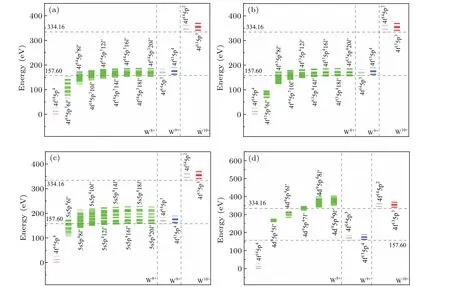
Fig.1.The energy levels of W8+, W9+, and W10+ configurations considered in this paper.Where red indicates even configurations, blue indicates odd configurations, and green indicates part of excited state energy levels for 5p subshell (a), 4f subshell (b), 5s subshell (c), 4d subshell(d)electrons excited to n ≤20,l′≤6.
3.1.2.Comparison of theoretical and experimental result
In Table 1, we present the ionization thresholds for the outer subshell electrons of both the ground state and the excited state 5p35d configuration of the W8+ion.Experimental results and NIST recommended values are included for comparison.Notably, the deviation between theoretical calculations and experimental results does not exceeds 1 eV.

Table 1.Threshold energies for the ionization of electrons in the outer subshells of W8+ ion ground state 4f145p4 and excited state 5p35d.
Based on Fig.1, the DI channel can be represented as follows:
According to Fig.1,the EA contribution within the EISI of W8+encompasses the 5p, 5s, 4f, and 4d subshells.These excitation channels can be expressed as
where 5≤n ≤20,l′≤6, These excitation channels can be performed via autoionization(AI)or radiative(RT)
All energy levels within the 5s,5p,and 4f hole system in DI are situated below the double ionization threshold.Figure 2 shows the contribution of the DI cross section originating from the 5p,5s,and 4f subshells.It is evident that the primary contribution to the DI cross section arises from the 4f subshell,while the contribution of the 5p and 5s subshells decreases successively.
Regarding the contribution ofnl′energy levels to the total cross section in the EA process of the ground state,we calculated the ratio ofnl′to the total EA cross section at the peak energy(i.e.,377 eV).As shown in Fig.3,the most significant contribution comes from excitations involvingnl′(n=5).Thenl′(n=20) level’s accounts for approximately 1.3% of the total EA cross section.Contributions from highernl′values beyond 20l′are expected to be even smaller.In this study,we have disregarded the contribution of thenl′(n >20)levels.
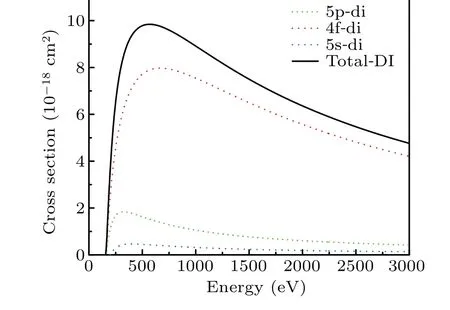
Fig.2.Present calculated direct ionization(DI)cross sections for the W8+ground state(contributions from different subshells).

Fig.3.The proportions of nl′ (n=5-20) energy levels to the total cross section in EA processes of ground state[Cd]4f145p4.

Fig.4.Accumulated excitation autoionization (EA) cross sections (contributions from different subshells) for the W8+ ground state.The shadow areas show contributions from different subshells.
Figure 4 illustrates the contribution ofnl′energy levels to the total cross section for EA,originating from the 5p,5s,4f,and 4d subshells.As observed in Fig.1, energy levels in the 5p-nl′and 4f-nl′configurations rarely reach the first ionization threshold.Consequently, the contributions of the 5p and 4f subshells to the overall EA cross section are minimal.It is evident that the primary contribution to the EA cross section arises from the excited states of the 5s-nl′and 4d-nl′configurations.
Figure 5 presents a comparison between our computed cross section for the ground state of the W8+ion and experimental results obtained by Stenkeet al.[7]It is evident that the theoretical cross section of the ground state is 20%lower than the experimental measurement at the peak energy (i.e.,300 eV).Notably, the experimental measurements reveal a significant ionization signal occurring near 100 eV(while we have calculated an ionization potential of 157.6 eV), indicating that the ionization channel has been opened well below the ionization potential of the ground state.[7]Therefore,it is imperative to consider for the influence of metastable states on the ionization cross section of W8+.
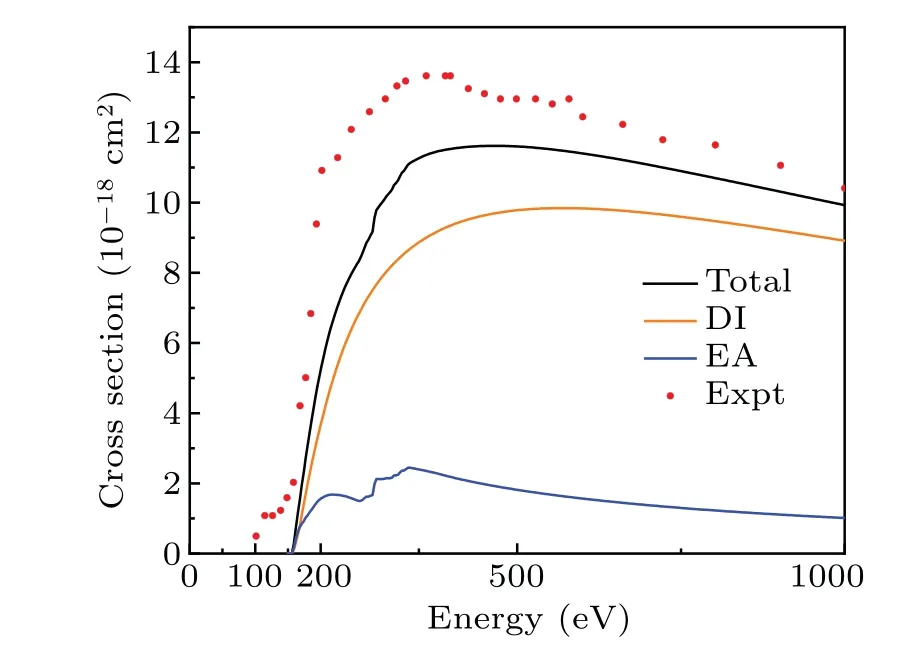
Fig.5.Total direct ionization (DI) and excitation autoionization (EA)cross sections for the W8+ ground state,comparison of total EISI cross sections with the experimental results.
3.2.Theoretical modeling of metastable fraction
We have computed the total ionization cross sections for the long-lived energy levels associated with the configurations 4f145p4,4f135p5,4f125p6,and 4f145p35d.All possible E1,E2,E3, M1, and M2 transitions have been considered from these energy levels to determine their lifetimes.Based on previous research, we understand that the lifetime of excited ions generated by the ion source must exceed 1.5×10-5s in order to reach the interaction region.[20]
Table 2 displays the lifetimes of specific energy levels within the aforementioned configurations 4f145p4, 4f135p5,4f125p6,and 4f145p35d.
Referring to Table 2,the four energy levels of ground state[Cd]4f145p4(see Table 2 for the indexi)have long lifetimes,their contributions to the total cross section should be considered,as shown in Fig.6(a).
3.2.1.The metastable configuration [Cd]4f135p5
The twelve energy levels of metastable [Cd]4f135p5(refer to Table 2 for indexi)exhibit long lifetimes,necessitating their inclusion in the evaluation of the total cross section, as illustrated in Fig.6(b).The DI channel can be expressed as

Table 2.Long-lived levels of W8+ and associated lifetimes.Only levels with lifetime over 1.5×10-5 s are presented.Note that a±b=a×10±b.
The EA process includes excitations from the 5s,5p,and 4f subshells of the metastable configuration.These excitations are graphically represented as
where 5≤n ≤12,l′≤6, These excitation channels can be performed via autoionization(AI)or radiative(RT)
3.2.2.The metastable configuration [Cd]4f125p6
The thirteen energy levels of metastable[Cd]4f125p6,indexed asiin Table 2,exhibit long lifetimes.It is important to take into account their contributions to the total cross-section,as depicted in Fig.6(c).The DI channel can be expressed as
The EA process includes excitations from the 5s, 5p, and 4f subshells of the metastable configuration.These excitations are graphically represented as
where 5≤n ≤12,l′≤6, These excitation channels can be performed via autoionization(AI)or radiative(RT)
3.2.3.The metastable configuration [Cd]4f145p35d
The six energy levels of metastable[Cd]4f145p35d(refer to Table 2 for indexi)exhibit long lifetimes.It is important to take into account their contributions to the total cross-section,as depicted in Fig.6(d).The DI channel can be expressed as
The EA process includes excitations from the 5s, 5p, and 4f subshells of the ground configuration.These excitations are graphically represented as
where 5≤n ≤12,l′≤6, These excitation channels can be performed via autoionization(AI)or radiative(RT)
In order to analyze the distribution of metastable energy levels,it is necessary to assess the fractionλi(indexi,see Table 2) of all possible energy levels.Due to the unavailability of this information from experimental data, Jonauskas introduced two models to fit the experimental data, and their validity has also been confirmed through calculations of Wq+(q=5,9,10).[20,22]
In the first model,a statistical weight was assigned to each contributing configuration


In this work,EISI cross sections have been computed for both the long-lived levels of the ground state(4f145p4)and the excited states(4f135p5,4f125p6,and 4f145p35d).From Fig.6,it is evident that under the same configuration, as the energy level indexi(see Table 2) increases, the ionization threshold for each energy level gradually decreases, and the ionization cross section correspondingly increases.Compared to the ground state 4f145p4, the cross sections for excited states 4f135p5and 4f125p6are smaller than that of the ground state,but the cross section for excited state 4f145p35d is greater than that of the ground state.
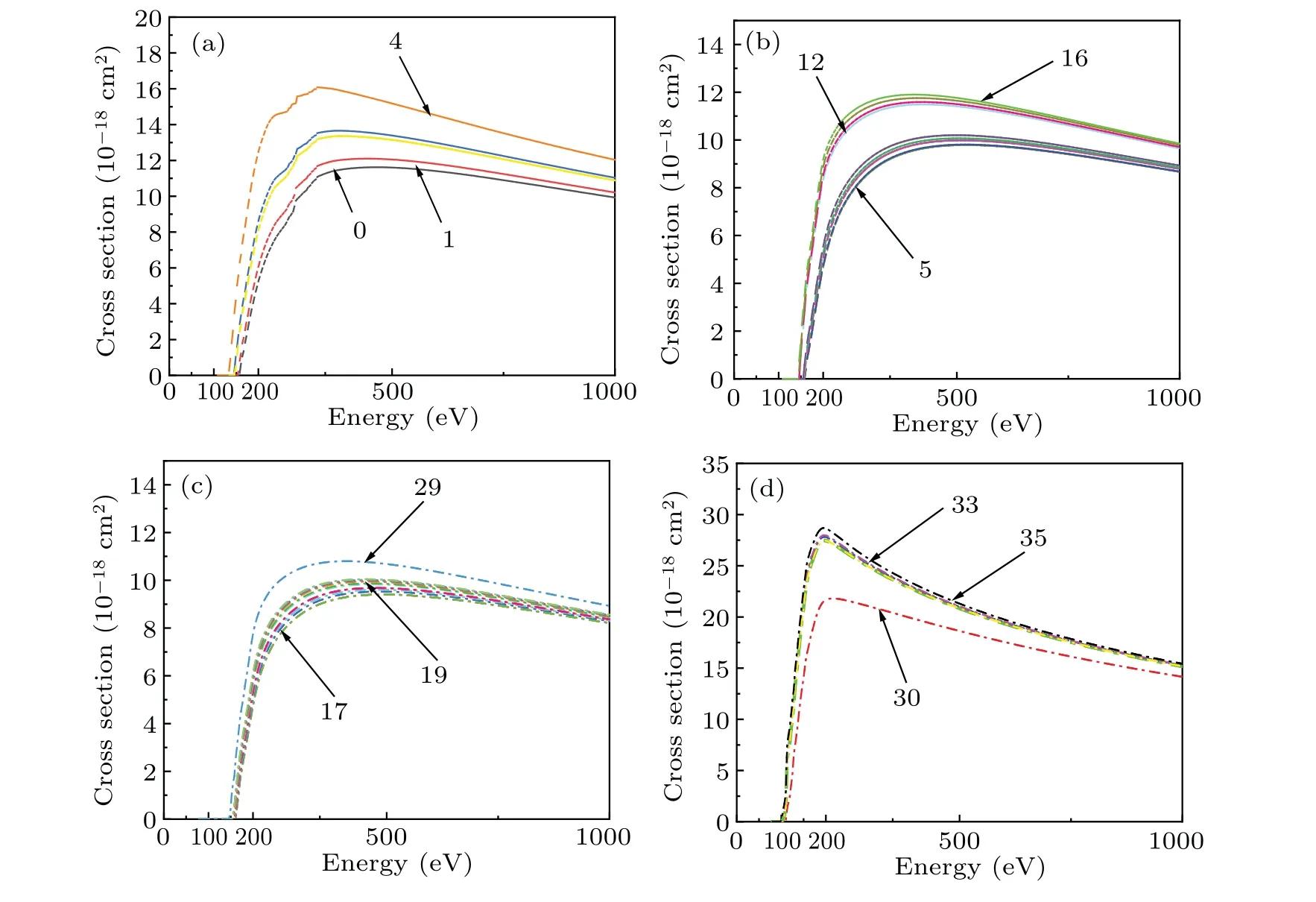
Fig.6.Cross sections for the long-lived levels of the ground state 4f145p4 (a)and the excited states 4f135p5 (b),4f125p6 (c),and 4f145p35d(d)long-lived energy levels.Few selected cross sections are labeled by their index given in Table 2.

Fig.7.Electron-impact ionization cross sections for the W8+ion ground state,blue dashed line: the result for model 1, yellow dashed line: the result for model 2, red dotted line: the experimental results of Stenke et al.,[7] green solid line and the black dashed line respectively represent the results obtained by fitting configurations 4f145p4, 4f135p5, 4f125p6, and 4f145p35d using two different models.
The comparison between the model cross sections and experimental data is shown in Fig.7.The blue dashed line represents the results of model 1, while the yellow dashed line represents the results of model 2.The corresponding fractions of ions in the relevant configurations are 79% for the ground state 4f145p4, 5% for 4f135p5, 5% for 4f125p6, and 11% for 4f145p35d.It can be observed that the differences between the two models are very minor, and the fitted results align more closely with the experimental data.
3.3.Plasma rate coefficients
In order to facilitate modeling of thermonuclear fusion plasmas, we have generated plasma rate coefficients (PRCs)from our calculated EISI cross section for the W8+ion ground state.The rate coefficientαi j(Te)for Maxwell-Boltzmann distribution at an electron temperatureTeis given by
HerekBis the Boltzmann constant,meis the electron mass,andσij(ε)is the cross section for the transition from the levelito the levelj.
Figure 8 illustrates the PRCs of the W8+ion transitioning from the ground state levelito all ionization final state levelsj,alongside previously reported data calculated by the FLYCHK code.[27]It is evident that the electronic temperature ranges from 0 K to 1.16×107K, with the results in the previous data slightly higher than our calculations.As the electronic temperature continues to rise,our calculated PRCs surpass existing results;however,our results exhibit a more pronounced decreasing trend.Therefore, after reaching 5.22×107K,the PRCs from our calculations once again fall below their values.Nonetheless,the currently available PRCs data show minimal distinctions from one another.The reason for this difference may be attributed to variations in calculation methods,and unfortunately,we are unable to obtain further calculation-related information from the database.Considering the uncertainty in calculations,our results are still considered acceptable.
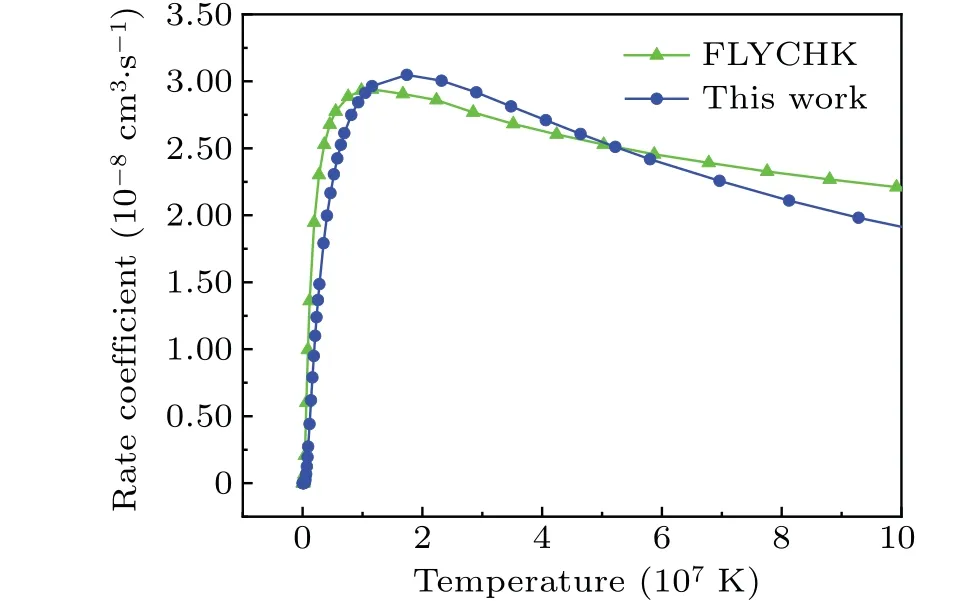
Fig.8.Present plasma rate coefficients for electron-impact single ionization of W8+ ions in the ground state(circle solid line).The triangle solid line represent the data calculated by the FLYCHK code.[27]
4.Summary and discussion
The EISI cross section for the ground state of the W8+ion was calculated using the level to level distorted-wave method implemented in the FAC code.The experimental results revealed a nonzero ionization signal below the ionization potential for the ground state 4f145p4, clearly indicating the presence of excited state ions in the parent ion beam.In order to estimate the metastable fractions, it was necessary to calculate the cross sections for all possible energy levels.Therefore theoretical cross sections were calculated for both the levels of the W8+ground configuration 4f145p4and the excited configurations 4f135p5,4f125p6,and 4f145p35d,all with lifetimes exceeding 1.5×10-5s.Assuming a 79% fraction of parent ions in ground configuration, the previous experimental measurements can be well reproduced.Additionally we derived the theoretical cross-section for the ground state as correlated plasma rate coefficients and compared it with existing data.It is reasonable to expect slight differences within the uncertainty range.
Acknowledgements
Project supported by the National Natural Science Foundation of China (Grant No.12364034), the National Key Research and Development Program of China (Grant No.2022YFA1602501), and the Science and Technology Project of Gansu Province,China(Grant No.23YFFA0074).
——中华第一玉龙
- Chinese Physics B的其它文章
- Does the Hartman effect exist in triangular barriers
- Quantum geometric tensor and the topological characterization of the extended Su–Schrieffer–Heeger model
- A lightweight symmetric image encryption cryptosystem in wavelet domain based on an improved sine map
- Effects of drive imbalance on the particle emission from a Bose–Einstein condensate in a one-dimensional lattice
- A new quantum key distribution resource allocation and routing optimization scheme
- Coexistence behavior of asymmetric attractors in hyperbolic-type memristive Hopfield neural network and its application in image encryption

